UTokyo-IIS Bulletin



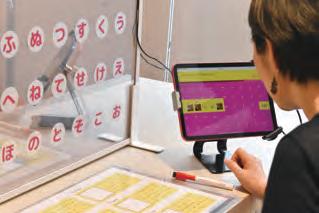

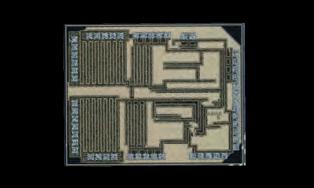
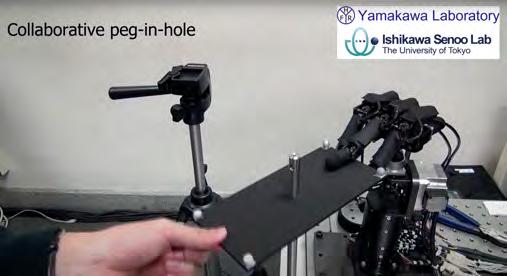
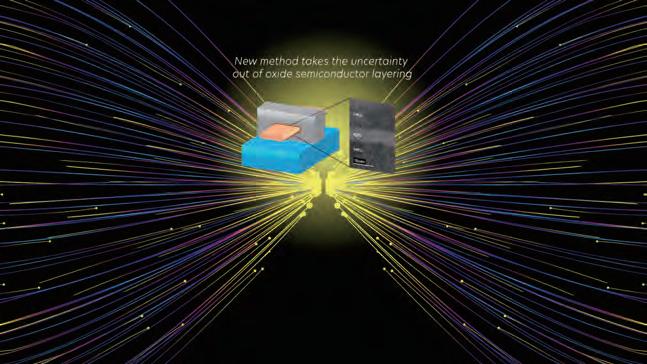
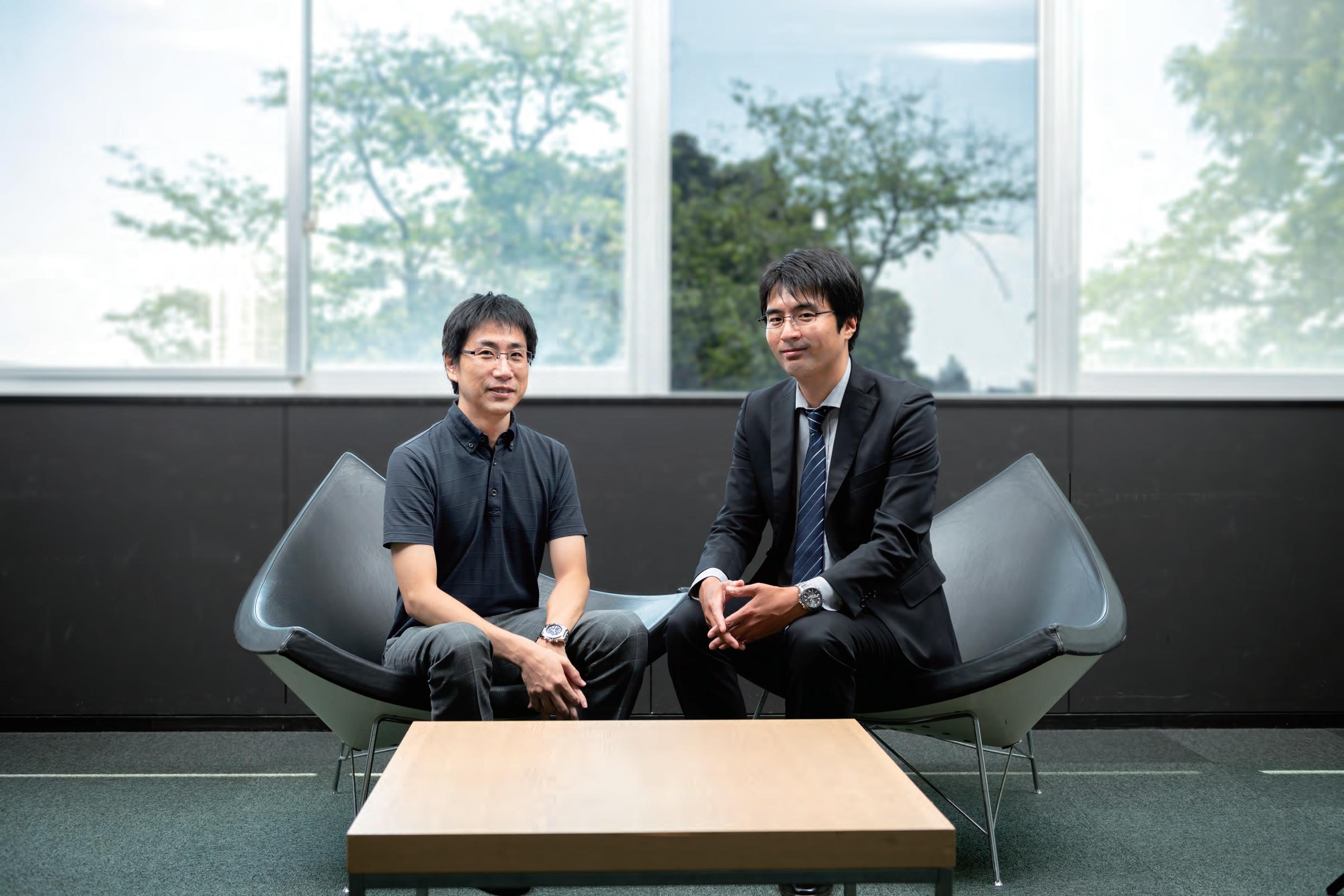














technology. The technology was the hallmark of the laboratory led by his mentor, Professor Masatoshi Ishikawa, who was a pioneering researcher in the field.
“I knew I wanted to conduct research on robots, but I had to choose a theme that truly intrigued me,” Yamakawa recalled. “After careful consideration, I realized that leveraging high-speed vision technology to handle deformable and soft objects would be the most promising course to follow.”
Even after obtaining his doctorate in 2011, Yamakawa’s passion for controlling robots to handle soft objects remained undiminished. In his lab at UTokyo-IIS, he has conducted numerous research projects, including estimating the state of deformable linear objects such as wires and strings.








Yamakawa Laboratory YouTube channel https://www.youtube.com/channel/UC4-gfMvWcULMdDqOi7H-KGA


Yamakawa so proposed using high-speed vision for a real-time human-robot collaborative (HRC) system based on visual feedback control, which was applied, for example, to a peg-in-hole task. The high-speed robot hand used features three fingers with a speed that far exceeds the performance of a human being.
The peg-in-hole task works as follows: A human moved a board measuring 22 centimeters in length and10 centimeters in width with retroreflective markers attached to its four corners. Despite changing the board’s position and orientation, the robot hand was able to insert the peg into the hole, which had a radius of about 6.3 millimeters. This was made possible through image-processing, which acquired image data at 1-millisecond
In recent years, Yamakawa has moved from the field of robotics into autonomous driving, believing his high-speed vision technology can be used for detecting pedestrians suddenly emerging in front of a car.

“Ordinary cameras mounted on vehicles are not fast enough to detect pedestrians coming in front of them,” he said. “The use of deep learning has

proven effective in predicting such situations. But the technology is based on past data. If something that the computer had never learned happens, it can’t deal with the situation.”


According to a new approach proposed by Yamakawa, potentially dangerous blind spots were detected by using a monocular camera and an algorithm developed for this purpose before arriving at the location. The new system is



Yamakawa’s main mission is to create the world’s fastest vision system. “If robots can ‘see’ their working environments and cope with situations promptly, they can work continuously without stopping the conveyer belt during production, whereas the belt has to remain stopped until their procedures are finished under the current situation. This enhancement can greatly improve the productivity of a factory.”
Yamakawa’s challenge is how to address a problem associated with the high-speed camera, which produces dark images. Yamakawa has added markers to the robot to process dark images, but eventually aims to enable the system to see without markers. This can be achieved by combining deep learning and high-speed image processing, thus enabling robots to move faster and more intelligently.

the board. The results were then sent to the real-time controller through a high-speed network so that the robot could precisely locate the board.
“We took advantage of the system’s high speed to let a robot play a leading role in collaborating with us, rather than the other way around. Previously, it was humans who went out of their way to collaborate with robots, which I found rather odd.”
I am amazed by how much we have common in our approaches to research. For example, we have to selectively see the obtained data, which is necessary for reducing the volume of real-time calculations when employing algorithms. So, it’s essential to extract only the data that is necessary.
designed to gather information on the depth of a location, through which the possibility of pedestrians being located behind structures is gauged. During a demonstration, pedestrians were detected as soon as they appeared in the images, even though only half of their bodies was visible.
“Our strength lies with speed, so it is best suited for detecting pedestrians coming out of blind spots,” Yamakawa said. “I believe our system could be the last resort in terms of avoiding collisions.”



Yamakawa believes that achieving this will expand the use of robots in various fields. “Faster and more intelligent robots will not only increase the production efficiency in the industrial fields but also ensure safety and improve the quality of life of humans by assuming more roles in household chores and elder care.”

That’s right. In case of high-speed vision, we observe only some of the data we obtain. For example, even if we obtain an image with 1,000 by 1,000 pixels, we look at a section with 100 by 100 pixels. It is important to reduce the volume of calculations and find ways to cut corners.
We’re both focusing on the potential of automated vehicles in our research. That’s another interesting thing we have in common.





How to maintain aging infrastructure has become a major challenge in Japan and many other parts of the world. Associate Professor Tsukasa Mizutani of UTokyo-IIS proposes detecting damage through what he calls “four-dimensional transparentization technology” (which incorporates a temporal axis and the use of radar) at an early stage. This approach is essential if governments want to reduce the cost of infrastructure maintenance.

Japan now faces the formidable task of maintaining its aging infrastructure, with many sections built during the nation’s era of high economic growth five decades ago. The severity of this challenge was highlighted in 2012 when hundreds of concrete ceiling panels of the Sasago Tunnel on the Chuo Expressway collapsed, killing nine people and injuring two others.


Mizutani was chosen to be a researcher of the Cabinet Office’s Strategic Innovation Program (SIP), which was launched two years after the disaster to look into how to spark innovation in maintaining the nation’s infrastructure. At that time, high expectations were placed on the introduction of pioneering electromagnetic wave

technology for infrastructure maintenance. His selection, therefore, was attributed to his graduate studies at UTokyo’s Graduate School of Engineering, where he analyzed electromagnetic waves emitted by antennas installed along railways for weather observation.

“It is important to detect internal damage of structures at an early stage, because, by the time damage becomes visible and detected, the structure is often in a serious condition, requiring major overhauls that take months, if not years,” Mizutani explained. “Thus, preventive maintenance with the use of radar is crucial to avoid traffic disruption and reduce costs.”
Mizutani employs two kinds of ground penetrating radar (GPR), which is a non-destructive subsurface inspection technology based on the reflection of electromagnetic waves.

One is a radar system mounted on a vehicle that is capable of monitoring the health of infrastructure at speeds up to 80 kilometers per hour without disrupting traffic. This multi-channel system consists of several


antennas aligned in a transverse direction, which corresponds to the radar channels, to construct dense 3D radar data. By adding a temporal axis, it becomes four-dimensional, enabling the detection of small amounts of damage that develop into major problems by surveying the same infrastructure over time. The other type is a portable radar equipped with a smartphone, which serves as a display and processor for the system.

According to an estimate made in 2018 by the Ministry of Land, Infrastructure, Transport and Tourism, the cost of breakdown maintenance is projected to reach about 280 trillion yen over the 30 years through 2048. On the other hand, the same estimate shows that preventive maintenance can potentially reduce the cost by about 30%, bringing it down to around 190 trillion yen.
Since his involvement in SIP, Mizutani has been developing technologies to safely and cost-effectively detect damage at an early stage by seeing through the infrastructure’s interior. He has become one of the pioneers in this field.
Typically, radar systems are designed for real-time human monitoring of the acquired data. Mizutani, however, is attempting to automate the monitoring process by using algorithms and artificial intelligence. His aim is to automatically pinpoint damage by distinguishing it from buried objects such as pipes.




“Our research is going pretty well,” Mizutani said, referring to demonstration results using an experimental test track. “We are able to see through the internal sections of structures, identifying the location of buried pipes and








damage.”







Mizutani Laboratory
https://mizutanilab.iis.u-tokyo.ac.jp/










The task of making this technology more accurate still faces obstacles. Even a 1% error rate translates to errors of 10,000 kilometers out of every 1 million kilometers of road. Enhancing precision is a daunting task. One example is developing optimal algorithms to eliminate noise in data caused by differences in the properties of antennas.


AI is used to distinguish objects in constructed images that cannot be easily discerned with the human eye, such as differentiating between an underground cave and a rock. However, a significant challenge arises in the form of insufficient teaching data for AI, as correct data to identify damage is not readily available. Mizutani is compensating for this shortfall by

Mizutani’s ultimate goal is to create a real-time underground version of Google Maps while gathering data from a traveling vehicle.






“At present, Google Maps is used as primary data for various purposes, such as searching for shops and restaurants, navigation and specific research mapping,” Mizutani said. “I believe that an underground version could serve as a primary dataset, triggering a revolution in the construction sector.”

There is a significant demand for digital transformation in the construction sector, which


often is characterized by outdated and dangerous practices. For instance, if the location of underground rocks can be detected in advance, piles can be driven into the ground in a way to avoid the rocks. “Having primary underground data will be indispensable if we want to realize fully unmanned operations in this sector,” Mizutani added.
The key to creating this kind of map lies in the introduction of driverless vehicles. China and the United States have already launched services using autonomous vehicle prototypes. If Japan follows suit and adopts such a service, autonomous vehicles can be equipped with
incorporating simulation data, and by combining AI with signal and image-processing technologies.
Another challenge involves rapidly filtering out irrelevant data for damage detection to reduce the volume of calculations, he added.











radar and various other sensors. This would enable automated sensing of underground areas around the clock without interruption, and allow for repeated measurements of the same sections to gauge temporal changes.

“If such a system is completed, I would like to showcase it as Japan’s first automated infrastructure maintenance system to the world, which is facing infrastructure maintenance challenges,” Mizutani said. Such an achievement could lead to the establishment of a new academic domain which he called “infrastructure transparentization engineering,” which he hopes to pioneer.
Yamakawa P2-3 Mizutani
We both graduated from a National Institute of Technology (Kosen) before entering UTokyo. Creating algorithms to mimic human senses is very important, and we honed that engineering sense while we attended the Kosen. That’s a great asset.
Yes, at the Kosen we were able to link theories to practical use. We acquired a sense of how to apply formulas, instead of memorizing them for the sake of learning. And we both hail from families with engineering backgrounds, which helped us learn which approaches work best. Translating what human being are thinking into the form of algorithms is very interesting.
In that sense, I am using external force and tactile sensors and deep learning, in addition to high-speed vision, to enable a robot hand to recognize whether a moving object is fragile when it attempts to grab it.
 ▲ Augmented reality representation of the road surface below on Google Street View Research by Muhammad Moosa KAZIM, 2nd year Master's student in Mizutani Lab
▲ Augmented reality representation of the road surface below on Google Street View Research by Muhammad Moosa KAZIM, 2nd year Master's student in Mizutani Lab


The AICOM project aims to democratize AI research by transforming the collection of training data for gaze estimation into an enjoyable game. Participants play cooperatively, using their eye gaze to communicate words while their face images are captured. The project received positive feedback during a demonstration experiment, engaging diverse people and fostering discussions about gaze estimation AI and AI applications. The project aims to extend its approach to other AI research areas, making AI research accessible to a broader audience and incorporating diverse perspectives.
AI has been gaining increasing attention in recent times. Its applications and potential have captured the imagination of various industries and researchers. However, this expansion of AI technology also brings concerns about AI systems' black-box nature. As AI becomes more large-scale and complex, it becomes harder for humans to imagine and understand how it is made. This lack of transparency raises ethical questions and could result in unintended consequences. The backbone of machine learning models is the training data they rely on. It is also a critical issue that such training datasets can carry data biases, leading to unfair or discriminatory outcomes. Addressing these challenges requires democratizing AI research and development, making it accessible to not just experts but also the general public. The critical question is how we can involve people in AI research; this is where the AICOM project comes into play.
As a collaboration between the UTokyo-IIS’ Design-Led X Platform (DLX Design Lab) and Yusuke Sugano lab, the AICOM project aims to engage a diverse audience in AI research. By transforming the process of collecting training data for machine learning-based gaze estimation into an enjoyable game, we expect people from various backgrounds can participate and contribute to the research process.


Gaze estimation is a technique for inferring where a person is looking. Sugano lab has been developing machine learning-based gaze estimation techniques to perform gaze estimation using only ordinary cameras. Many face images with the correct annotation of gaze direction are required to train such gaze estimation models.
The AICOM game is designed for two participants to play cooperatively, and the objective is to use eye gaze to communicate words to the other player. The player's face image is captured while looking at the letters on the transparent letter board, and a face image dataset associated with ground-truth gaze directions is acquired through the game.


From July 3-7, a demonstration experiment for the AICOM project took place at the IIS’ Dining Lab, a dining facility where cutting-edge research is conducted to shape tomorrow's lifestyles. The game system was installed at the Dining Lab, and a diverse group of people, including visitors to the facility, could experience the game and contribute to the data collection procedure. The response from the participants was positive, with everyone enjoying the game and showing interest in the research of gaze estimation AI. A small workshop was also held during the experiment, where participants engaged in lively discussions about gaze estimation techniques and AI applications.
The AICOM project aspires to expand its approach to other areas of AI research. By involving diverse people in diverse AI topics through physical and enjoyable experiences, the project aims to open the process of AI research to a broader audience and to develop AI based on various perspectives.
Sugano Laboratory https://ivi.iis.u-tokyo.ac.jp/ https://www.designlab.ac/post/aicom-democratised-and-co-creative-ai-research
Artificial intelligence is widely applied in digital games: It can sense the entire situation of a game and affect the game by giving orders to characters or objects. This revolutionary technology can also be used for real-world applications. My idea is to harness AI technology to create a smart city or a huge AI system that is capable of protecting residents against natural disasters, for example, and making life better for them.


Ihave been researching and developing AI for digital games since 2004. Game AI means AI for board games such as chess, go and shogi, but my field of study for digital game AI is real-time interactive AI that is used in digital games. The technology is applied in such games as action, role-playing and online, generating responsive, adaptive and intelligent behaviors or dialogues between characters.


There are three kinds of AI in digital game AI: meta AI, character AI, and spatial AI. Character AI is the brain of a robot or agent. An AI that controls such characters, objects, and the game world is called meta AI. AI for space is called spatial AI. An autonomous distributed cooperative model connecting these three AIs is called the MCS-AI Dynamic Cooperative Model. My research involves utilizing this model as an architecture for a smart city to make the city itself AI.








































































Dynamic allocation of enemies Observing level in real time Direction for agents Making progress in game
Preparing data to make meta-AI and character AI recognize the level Managing object representation Managing navigation data Path-finding / Tactical point analysis

Spatial AI has its own domain space, recognizes the situation within the space, and orders and influences the agents and machines in the space. Spatial AI also transfers its own spatial information to the metaverse to link the smart city and the metaverse. A space that spatial AI controls is called a smart space. In a smart

space, spatial AI transfers spatial information of the space to an agent and a robot dynamically, and they can behave intelligently in the space. A smart space is the minimum unit of a smart city. A smart city can be realized by connecting many smart spaces and covering the city with them.

A smart city has its own AI and protects the city and its inhabitants against the external environment, such as the atmosphere and disasters. Smart city AI understands the internal state of city itself as a body and takes care of it. Smart city AI has a digital twin of the city and simulates and predicts the near future of the city by using a game engine. The reason why a smart city uses a game engine is that it is a useful tool to simulate the world and is the best visualization tool for storing a great deal of spatial data. Smart cities are not only necessary architecture for the Earth, but also for cities on the Moon and Mars in the future.

et home, take off your mask and toss it in the bin. This daily ritual might change soon, however, thanks to scientists from IIS.

The researchers have developed a compact system that can restore N95 respirators and surgical masks that have been exposed to moisture to 97% efficiency. By using a special circuit and a conductive plate, a large and uniform voltage distribution recharges the mask in about one minute. This machine can help address the need for high-performance masks while reducing plastic medical waste.






During the recent COVID-19 pandemic, surgical masks and N95 respirators were in high demand, because these were some of the best tools available for reducing the risk of catching or transmitting the SARS-CoV-2 virus. Remarkably, the pore size of these masks, about 10 microns, is much larger than the size of virus-carrying aerosol droplets, which are about one micron. However, the reason the masks are still so good at capturing droplets is that the polypropylene mesh inside them carries a static electric charge, which can attract the droplets via electrostatic force. However, over time or as a mask becomes wet, this effect becomes significantly reduced, hindering effectiveness. “Humidity, including exposure to exhaled air, or washing in water removes a mask’s charge and compromises its filtering efficiency,” says lead author Taisuke Ikawa. As a result, most used masks were discarded, instead of being sterilized and
The device built by the research team is based on an electrical circuit called a Cockcroft-Walton’s voltage multiplier. This allows electrical potentials of up to 40,000 volts to be obtained in a compact device. The researchers used a conductive aluminum plate as an electrode to ensure a homogenous voltage distribution, and covered it with an insulating plastic PET board to suppress














The efficiency of the masks was tested after being washed in water; efficiency was significantly restored after brief exposure to the electric field generated by the device. “Our work raises the possibility that masks can be sterilized and recharged again and again, significantly increasing supply,” says senior author Kaori Sugihara. Future research may scale up the size of the device to help increase



Researchers at UTokyo-IIS have developed a desktop charger with voltages high enough to replenish the electric charge on N95 and surgical masks, which is required for effective use.
Researchers at UTokyo-IIS develop a gate driver for circuit bipolar transistor electronic switches with a timing function robust to changes in current and temperature, which can be used in many industrial control applications

Many homes have electronic timers for automatically turning lights on or off automatically the same time each day.
However, the precise control of larger electrical devices requires more sophisticated electronics. Scientists from IIS have successfully developed a programmable gate driver for solid-state electronic transistor switches, and using empirical tests, show that their device showed reduced switching loss even under changes in input current and temperature fluctuations.
even addition, systems timing
Insulated-gate bipolar transistors (IGBTs) are semiconductor electronic elements that can be used in rapid electronic switches of high-powered devices. Because they can control electric loads up to hundreds of kilowatts, IGBTs are suitable for operating of power supplies, traction motors, or induction heaters. In addition, owing to their ability to switch on and off quickly, IGBTs can also be used for control systems in industrial applications. However, these switches can experience switching loss based on variations in the input current or temperature. Creating a device with automatic timing would help improve the reliability of these systems.
time devices. integration
as a function of time by sensing the voltage of the parasitic inductance, which is an unavoidable effect present in electronic devices. The research team tested the performance of the new device over a wide range of temperatures. Their single-chip integration of a timing mechanism allowed for lower cost while maintaining precise control. The fact that it remained stable under fluctuating operating conditions allowed a single programmable device to replace a collection of different products optimized for different situations.
“Being able to provide programmable, real-time control at low cost should hasten adoption of this type of device,” says Makoto Takamiya, senior author. This work may lead to more flexible and reliable control of large electrical currents, and future designs may be extended to include more complex programming features.




adoption device,” says Makoto reliable control designs may programming





Reference “Digital Gate Driver IC with Fully Integrated Automatic Timing Control Function in Stop-and-Go Gate Drive for IGBTs” IEEE Applied Power Electronics Conference and Exposition (APEC)(2022)






research team led by Masaharu Kobayashi reported a deposition process for nanosheet oxide semiconductor. The atomic layer deposition technique was demonstrated for producing field effect transistors for 3D integrated circuits at low processing temperature. The resulting devices were shown to have high mobility and reliability and are expected to allow high functionality and manufacturability for a range of electronic devices.


VLSI Symposium 2023
Further information
https://www.iis.u-tokyo.ac.jp/en/news/4233/
Aresearch team led by Teruyasu Mizoguchi used a machine-learning method to improve interpretations of experimental data for understanding the electronic structure of organic molecules. By training an artificial deep neural network with simulated data, they were able to predict the density of electronic states from core-loss spectroscopy data, which may improve chemical engineering.
The Journal of Physical Chemistry Letters (2023), DOI:10.1021/acs.jpclett.3c00142
Further information
https://www.iis.u-tokyo.ac.jp/en/news/4221/

River flooding is expected to become more frequent and more severe under climate change. Future hazard maps estimating local flooding can help communities adapt. A research team led by Dai Yamazaki examined two methods of constructing future hazard maps and found that maps created by lookup method were more accurate. These maps revealed populated areas missed by the historical maps that would be at risk of severe flooding under climate change.
Hydrology and Earth System Science (2023), DOI: 10.5194/hess-27-1627-2023
Further information
https://www.iis.u-tokyo.ac.jp/en/news/4192/
Aresearch team led by Masahiro Nomura used theoretical and experimental data to explicate the process of fluid-like flow of thermal energy in graphite samples. This work can lead to more efficient and cheaper heat-dissipation devices.
Nature Communications (2023), DOI: 10.1038/s41467-023-37380-5
Further information
https://www.iis.u-tokyo.ac.jp/en/news/4186/




The Covid-19 pandemic has transformed our lives, making us realize the limits of science and technology against formidable viruses. At the same time, through remote work and online lectures, we have become more aware of the importance and the future potential of digital transformation (DX). Many issues cannot be solved by technology alone. However, engineering is expected to play an increasingly important role in meeting the challenges of modern society, which has become ever more
The Institute of Industrial Science (IIS) at the University of Tokyo is the largest university-affiliated research institute in Japan. With a commitment to pursuing academic truth, the UTokyo-IIS carries out a wide range of educational and research activities, such as cross-disciplinary research that transcends academic boundaries — which is a traditional feature of the UTokyo-IIS — as well as practical industry–academic collaboration, international collaboration, and hands-on research aimed at social implementation.
In 2019, we celebrated our 70th anniversary. During the past 70 years, there have been significant research accomplishments and we have succeeded in producing many outstanding members of society.
The UTokyo-IIS is a comprehensive engineering research institute that covers almost all fields of engineering, consisting of five research divisions. It has approximately 120 laboratories overseen by professors, associate professors, and lecturers. More than 1,300 personnel, comprising approximately 250 faculty members, 150 support members, and 900 graduate students and postdocs participate in educational and research activities that are responsible for producing excellent research outcomes and fostering outstanding talent.
Furthermore, there are 3 affiliated research centers that span multiple research departments, 7 internal centers, 2 collaborative research centers, and an international collaborative research center that pursues international joint research. In addition to promoting original research in specialized fields, each laboratory systematically engages in interdisciplinary or international activities by using organizations such as the cross-disciplinary research centers.
In 2017, the Chiba Experiment Station was relocated from its original site in Nishi-Chiba to the Kashiwa Campus, and since 2020, the facility is operating as a Large-scale Experiment and Advanced-analysis Platform (LEAP). In addition, a completely new facility called the “Design-Led X Platform,” the first of its kind, has also begun operations in 2017.
Since the foundation of the UTokyo-IIS, we have been acutely aware that the significance of academic research in engineering lies in its real-world implementation. Not only have we created new academic fields through enhanced specialization and collaboration across disciplines, but we have also developed and deployed technologies that can contribute to solving problems in the real world. In addition, we have made it our mission to develop individuals who will shoulder the responsibility of developing and
Professor Toru H. Okabe, Director General
disseminating technology in the industrial world.


The spirit and the sense of mission of the UTokyo-IIS since its establishment still live on, and we tackle various engineering-related issues in a practical manner as a pioneering organization advocating industry–academic collaboration.
Such achievements and such a proactive stance are widely recognized, along with the name SEIKEN (short name for IIS in Japanese).
We seek to create a new “SEIKEN style” as we continue to pursue academic truth as a university research institute, contribute to the creation of new value through innovation, and aim for a multidisciplinary approach integrating humanities and sciences for implementation in the real world.
Although the UTokyo-IIS is the largest university research institute in Japan, it maintains a strong sense of unity as an organization. Using its agility and comprehensive capabilities, the UTokyo-IIS will continue to fulfill its role as one of the world’s top research institutes in the field of engineering. We believe that we will continue to make great contributions to society through research and education.
Institute of Industrial Science, The University of Tokyo (UTokyo-IIS)
https://www.iis.u-tokyo.ac.jp/
Kom ab a Research Campus(Komaba Ⅱ Campus)
4-6-1 Komaba Meguro-ku, TOKYO 153-8505, JAPAN
E-mail:koho.iis@gs.mail.u-tokyo.ac.jp
Kashiwa Campus
5-1-5 KASHIWANOHA KASHIWA-SHI, CHIBA 277-8574, JAPAN (Kashiwa Campus)
6-2-3 KASHIWANOHA KASHIWA-SHI, CHIBA 277-0882, JAPAN (Kashiwa Ⅱ Campus)
E-mail : kashiwa.iis@gs.mail.u-tokyo.ac.jp
Publications
https://issuu.com/utokyo-iis
Social media accounts
UTokyo.IIS.jp
https://www.facebook.com/UTokyo.IIS.jp


@UTokyo_IIS
https://twitter.com/UTokyo_IIS
